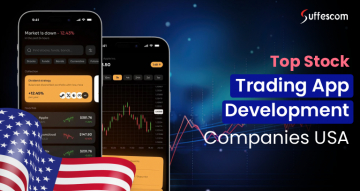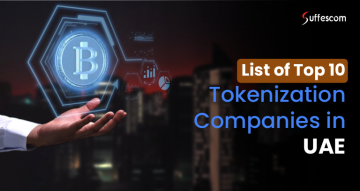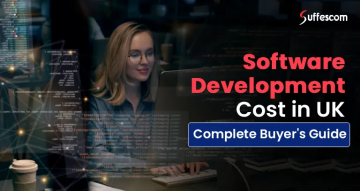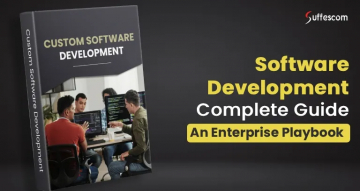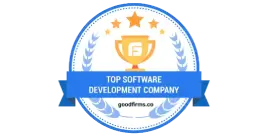How Much Does an App Like Flixster Cost in 2025?
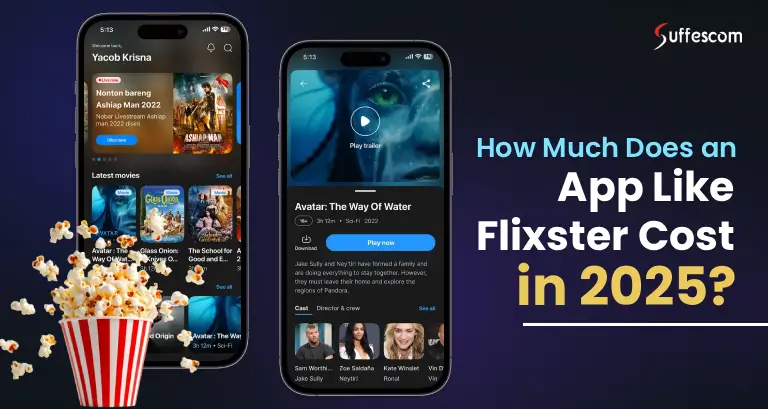
In the digital-first entertainment era, mobile apps have gained prominence for discovering movies, booking tickets, and streaming. Flixster is one of the apps that is gaining popularity fast. It also has 20 million apps downloaded. This demonstrates the growth in a Flixster-like application demand as OTT platforms have become mainstream, local cinemas are digitizing their services, and audiences want to have everything at their fingertips.
For entrepreneurs, production houses, and startups, the big question is: “How much does it cost to build an app like Flixster in 2025?” The answer isn’t straightforward. Its prices differed, based on features, platform (iOS, Android, or both), design complexity, backend infrastructure, and development location. A Flixster like app can cost approximately $8,000 to $25,000.
In this blog, we’ll discuss everything from its history to its features and costs. So, let’s get started.
What is Flixster?
Flixster was one of the early apps in the movie discovery and ticketing industry. Developed back in 2006, it gained very high popularity because customers could easily look up movies, watch trailers, read reviews, and buy tickets, all on one site. Unlike traditional cinema websites, Flixster introduced the community aspect as the viewers could rate films, share their watchlists, and comment on the releases with their friends.
Furthermore, its growth accelerated when it acquired Rotten Tomatoes, the world’s most recognized film review aggregator, in 2011. This step provided Flixster with easy access to one of the most reliable sources of movie ratings, which made this app an even better platform among film enthusiasts. Flixster was later bought by Warner Bros., which made the platform a component of a larger digital media system.
Over the years, the app introduced multiple features, including digital downloads, DVD rentals, and limited streaming integrations. In spite of these innovations, pressure mounted on Flixster with the entry of other platforms, which prompted it to struggle to ensure that it remains on top. By 2018, the app was officially discontinued, but its influence on how audiences discover and engage with movies remains important.
Today, Flixster serves as a blueprint for entertainment platform development. Businesses are using its model as inspiration while adding next-gen features.
Why Businesses Are Building Flixster-like Apps in 2025
In 2025, companies wanting to launch their own Flixster-type app need to pay greater attention to the trends and demands of the constantly-changing digital entertainment field. With the market size of video streaming services, the average revenue per user is projected to reach $78.97 in 2025, which shows the need for such apps.
Rising Demand for Movie Discovery & Ticketing Apps
The way people use entertainment has shifted dramatically. In 2025, audiences prefer digital experiences where they can discover and book movies in a single app. Traditional ticket counters often frustrate users, making Flixster like apps more appealing.
Business-wise, an application like Flixster can fill the gap between the cinemas, the streaming services, and the users. It is convenient in terms of searching reviews, finding schedules, and buying tickets immediately.
Streaming Culture & Digital Movie Ecosystems
Streaming giants have changed how audiences watch movies. Viewers no longer rely only on in-theater releases, but prefer to enjoy trailers and OTT previews and have preferred options to the new hybrid digital releases. An app like Flixster should also support this new digital ecosystem, as it allows users to purchase tickets to a movie, stream previews, and recommendations.
In 2025, the OTT industry and cinema industry will overlap more than ever as Revenue in the OTT Video market worldwide is projected to reach $343.82bn in 2025. The studios release movies simultaneously in the cinemas and via streaming applications. Businesses that give users a unified platform stay relevant and gain more user engagement and loyalty.
Localized Entertainment Experiences
The entertainment industry is becoming hyper-localized. Audiences in the USA prefer nearby cinemas, regional OTT platforms, and offers that reflect their lifestyle. The Flixster-type app can be personalized to provide location-focused feedback, including feedback on showtimes and offers of tickets close by and the feedback on areas streaming near.
Through geo-targeting and writing in the local language, apps can increase user retention. Apps such as Flixster, which integrate international movie databases with the locals, will get success in 2025.
Core Features to Include in a Flixster-like App

To develop an app like Flixster, it is really important to know the core features that you want to include in your app in 2025. Here are some of the core features you can integrate into your Flixster-like app:
User Panel Features
A Flixster-like app is centered around the user panel. It must serve a smooth and engaging experience that will make audiences come again.
- Registration & Login: Fast sign up via email, phone number, or social networking account in order to avoid the friction of onboarding.
- Browse & Search Movies: Users should be able to search upcoming releases, trending, and classics with comprehensive movie data.
- Ticket Booking and Showtimes: There should be integration with the cinema to access the available showtimes and to enable booking of tickets with secure payment options.
- Reviews, Ratings & Watchlists: The ability of users to create watchlists, comment, and rate movies is one way to develop a high level of engagement and communities.
- Video Previews & Trailers: Pre-built streaming with trailers and teasers makes the experience better, more immersive, and with more retention.
The user-centric panel guarantees that navigation, personalization, and speed get emphasis, thus giving users a reason to remain in the app rather than switching to more apps.
Admin Panel Features
While users enjoy the app’s interface, businesses require a robust administrative panel to control the content and operations.
- User management: Monitor, moderate, and assist user activity with ease.
- Movie and Content Control: Add or edit the movie attributes and posters, trailers, and ratings on a real-time basis.
- Ticketing Control: Control the tickets, ticket booking, cancellations, and cinema alliances.
- Analytics & Reporting: Analyse the performance of the apps and revenue channels and have a clear understanding of user behavior through dashboards.
An efficient administration panel gives businesses the power to be in control, streamline user experience, and grow without problems.
Advanced Features to Stand Out
In order to compete in 2025, it is not enough to have basic functionality. Cutting-edge features are required to make sure your app doesn’t just replicate Flixster but surpasses it.
- AI Recommendations: Personalized AI recommendations using the viewing, preferences, or rating history to increase engagement.
- Social Sharing & In-app Groups: Enable the user to share reviews, form movie groups, and host movie watch parties via the app.
- OTT Platform integration: Integrating with Netflix, Hulu, Prime Video, or local OTT solutions provides the customer with a hybrid entertainment platform.
- AR/VR Movie Trailer Previews: The users are able to watch immersive trailers or 360-degree filming in the set.
- The Geo-location-based Cinemas & Offers: List the theatres nearest to you, offers, and reward programs.
Such innovations turn the app into not only a utility tool but a place of amusement, increasing the satisfaction of the users and the revenue possibilities of the application.
Let’s Build Your Flixster Like Streaming App Together!
Get in touch with us today to transform your vision into an app.
Factors That Influence the Cost of a Flixster-like App
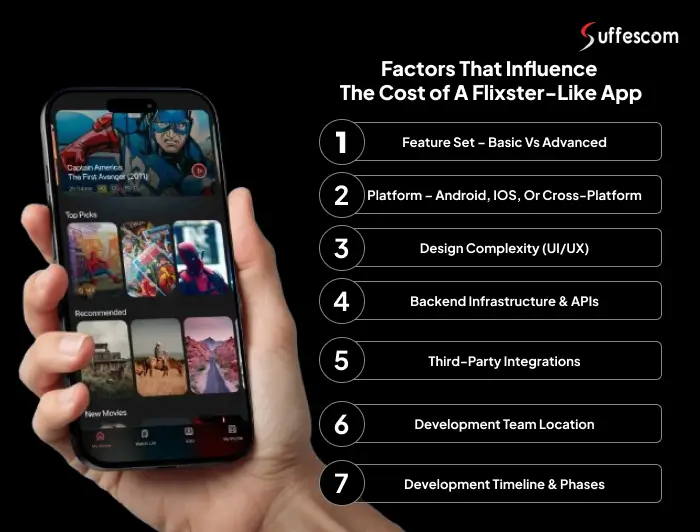
After knowing the features, it is really important to know about the factors that impact the overall movie app development cost. Here are some of the main factors:
Feature Set – Basic vs Advanced
The number and complexity of features play the biggest role in cost. A basic Flixster clone app with browsing and ticket booking can be developed at a lower budget.
But once AI-based recommendations, OTT matching, AR/VR previews, and analytics dashboarding are added, it increases costs. Companies have to choose between starting lean with MVP or making a higher investment in a richly featured app.
Platform – Android, iOS, or Cross-platform
Choosing the right platform directly impacts development cost and timeline.
- iOS or Android (Native Apps): Gives superior performance and user experience, but needs individual development, which doubles the overall app development cost.
- Cross-platform (Flutter, React Native): Allows the utilisation of one codebase across both platforms, which can decrease costs.
- Progressive Web Apps (PWA): A lightweight alternative for web-based audiences, though less powerful than native apps.
It is up to you to decide according to your target consumers, scalability objectives, and finances.
Design Complexity (UI/UX)
Entertainment apps depend on the user experience a lot. Simple structure and basic navigation are cheaper, whereas complex animations, custom branding, and movie trailer videos require expanded resources.
Such a cinema-style interface, including AR elements, e.g., would be more time-consuming, would require more specialized skills, and would cost more. Companies that wish to have their app gain a competitive advantage will have to invest in UI/UX design that is both aesthetic and functional.
Backend Infrastructure & APIs
The backend drives the performance and scalability of the app. MVP can use a lightweight backend, but sophisticated applications require:
- AWS, Google Cloud, and Azure Amazon Web Services
- High traffic during the new release servers that are scalable
- Safe user ID & payments
- Ticketing, OTT, and third-party movie databases integration APIs
The complexity of backend development determines cost. Real-time ticket validation and AI-recommendations apps have greater demands on their infrastructure, thus adding to the overall cost.
Third-party Integrations
The Flixster-like applications depend on third-party APIs to access correct information on movies, the ratings, as well as payment. Licensing from providers like TMDb, Rotten Tomatoes, or Fandango may add recurring costs.
Likewise, connection of secure payment gateways such as Stripe, PayPal, or Apple Pay needs additional development time and confirmation procedures. Every integration introduces value as well as cost, so it would be advisable that businesses focus on the necessary integrations.
Development Team Location
The geographical location of the developers you employ contributes immensely to cost:
- USA & Western Europe: High-quality but expensive.
- Eastern Europe: Proven developers at moderate prices.
- India & SE Asia: Most cost-effective for startups.
Although offshore teams save money, they demand good project management and communication since it makes the process of delivery more effective. Other businesses adopt a hybrid model, moving design/strategy to the USA, but outsourcing Flixster like app development in order to save costs.
Development Timeline & Phases
The longer the timelines, the more expensive it becomes to develop apps like Flixster. Rushed projects might involve more people, and this adds to costs. The development of a typical Flixster-like app takes between 4 and 6 months.
Furthermore, the creation of more features and technologies increases expenses as the development cycle would also expand.
Development Cost Breakdown – USA vs Offshore
To build Flixster like clone app involves higher hourly rates than in offshore regions where the development is more economical. This section highlights the pricing gap and factors influencing your choice.
Cost in the USA
App development in the USA is known for high hourly rates but premium quality. It is a secure option as it is both developed by competent developers and has high standards of compliance, and the support of a highly developed infrastructure.
Cost in India, Eastern Europe, and SE Asia
Offshore outsourcing is one of the most common practices to reduce the cost of Flixster like app development and yet tap into the pool of quality talent.
This trade-off comes with the fact that offshore projects will be open to the aspect of time zones, communication difficulties, and an extended project cycle. But given the appropriate project management tools, offshore teams can produce high-quality apps.
In-house vs Outsourcing Comparison
Businesses often debate whether to hire an in-house team or outsource.
- In-house Development: It provides total control and improved alignment with company culture. It is, however, costly (usually $200,000+ per year) since it entails fixed salaries, infrastructure installation, and constant overheads.
- Outsourcing: Contains the ability to obtain professionals on a temporary basis in terms of the scope of the project. It saves the initial expenses and facilitates quick scaling, particularly among startups, which are testing the market.
Total Rough Estimate
Here’s a rough estimate of total Flixster app development cost for different complexities:
- MVP Version (Basic Flixster Clone): $8,000 – $15,000
- Includes necessary functionalities such as browsing, reviews, watchlists, and simple ticketing. It is highly suitable for startups.
- Mid-range App (with streaming + social): $15,000 – $20,000
- These apps have functionalities like video trailers and social sharing. Best for businesses targeting regional audiences.
- Full-scale App (Decentralized OTT integrations, AI, analytics): $20,000 – $25,000+
It includes all the functionalities and costs the most. Features include AI recommendation, AR/VR preview, and OTT integration. It is best for enterprises or investors for large-scale entertainment ecosystems.
These figures are rough approximations of Flixster app cost. Real costs to build Flixster like clone app can vary with the prioritization of features, the design complexity, and the location of the developer.
Development Timeline – How Long It Takes
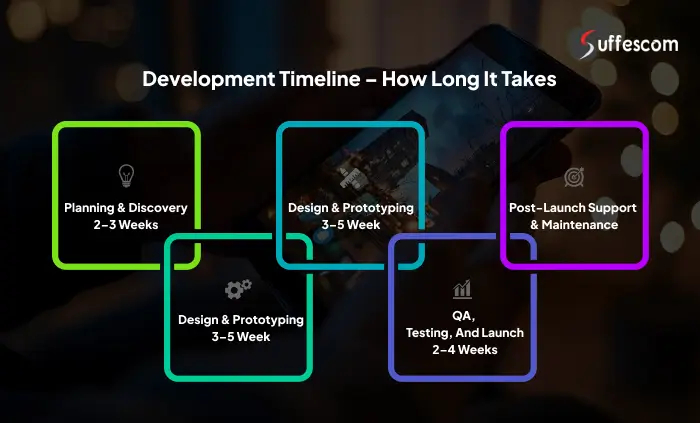
The timeline to make flixster like app depends on its phases. Now, let’s discover the timeline of building an app like Flixster.
Planning & Discovery: 2–3 Weeks
The initial stage includes market research, competitive analysis, and planning features. A mobile app development company and stakeholders work together to find the scope, target audience, and monetization model. Then, wireframes and flow diagrams are created in order to trace the user path. This will help in ensuring that there is a clear roadmap of the app, and there will not be reworks later at great expense.
Design & Prototyping: 3–5 Weeks
During this phase, UX/UI designers develop visual mockups and interactive prototypes. From color schemes, navigation of the layout, all of this is directed to go along with the brand identity. A movie app like Flixster needs a very dynamic design that is entertaining and functional. The stage will also consist of testing of prototypes by the user to improve the flow prior to the start of development. An excellent prototype also limits the mistakes.
Frontend & Backend Development: 8–12 Weeks
This is the longest and most resource-heavy phase. A frontend (what a user sees) and a backend (servers, APIs, databases) are built by app developers. Basic features such as movie search, watchlists, and streaming trailers, as well as payment integration, are incorporated and high-end features, such as AI-based recommendations, AR/VR previews, and OTT integrations, are coded as well.
Based on the selected platform, this stage may need parallel teams. Agile methodology is often used, with development split into 2–3 week sprints for faster delivery and feedback cycles.
QA, Testing, and Launch: 2–4 Weeks
Before launch, the app undergoes quality assurance (QA) testing to ensure bugs are detected and resolved. Testing covers:
- Functional Testing: Tests essential functionalities such as ticketing, reviews, and streaming.
- Performance Testing: Verifies that the app functions well when it is under high traffic.
- Security Testing: Ensures secure payment processing and secure coverage of user information.
After the approval, the application is released in the App Store and Google Play.
Post-Launch Support & Maintenance
After launch, ongoing maintenance is also important. This encapsulates updates, bug fixes, and performance monitoring. It is a continuous process, so it doesn’t have a specific timeline.
Recommended Tech Stack for a Movie App like Flixster
The selection of a proper technology stack can be one of the most important factors while creating a high-performance Flixster-like application. Here is the best tech stack for an app like Flixster:
Frontend
The frontend is what users see when they use the app, so it should be attractive and responsive.
- Cross-Platform Choices: React Native, Flutter
- UI Frameworks: Jetpack Compose, SwiftUI
- Mobile Platforms: Swift (iOS), Kotlin/Java (Android)
Backend
The backend guarantees the flow of data and smooth app performance.
- Programming Languages: Node.js, Python, Java, Ruby on Rails
- Databases: PostgreSQL, MySQL, MongoDB (for handling large movie metadata)
- Server Management: AWS, Microsoft Azure
APIs and Integrations
The important APIs and integrations for an app like Flixster include:
- Payment Gateway: Stripe, PayPal, Razorpay
- Social Media Integration: Facebook SDK, Twitter API, Instagram API
- Location Services: Google Maps API, Apple MapKit
- Video Streaming: AWS Media Services, Vimeo API, Brightcove
Security Technologies
Since apps handle sensitive user data and payment details, security is critical:
- Data Encryption: AES 256-bit encryption
- Secure Authentication: OAuth 2.0, JWT, Multi-Factor Authentication
Additional Tools and Services
- Push Notifications: Firebase Cloud Messaging (FCM), OneSignal
- Analytics and Tracking: Google Analytics, Mixpanel, Firebase Analytics
- DevOps and CI/CD: Docker, Kubernetes, Jenkins, GitHub Actions
- Performance Monitoring: New Relic, Sentry, Datadog
The optimal tech stack makes the app future-proof and user-friendly.
Monetization Strategies for a Flixster-like App
There are several monetization strategies that you can include in your app, like Flixster. Let’s delve into some of them:
Ads (Interstitial, Video, Banners)
One of the most tested methods of maximizing the income of a movie app is advertising. Various ad types can be placed on the site in a way that does not produce a negative effect.
Key ad formats you can use:
- Interstitial ads: These are full-screen advertisements that appear between transitions.
- Video advertising: These types of ads are shown before or after the trailers to increase the engagement rate.
- Banner: Non-intrusive ads placed on the homepage or movie lists.
Subscription Models
Subscription services offer high revenue since they guarantee a stable and steady stream and give users high value without advertisements. The model goes especially well in combination with some exclusive features, which could not be available to free users.
Options to consider:
- Freemium model: Basic features are given to free users and a premium review, early access to trailers, or no advertising are given to the paid users.
- Tiered plans: Monthly or yearly subscriptions that contain varying benefit levels.
- Family or group plans: Multiple users under one subscription for better reach.
In-app Purchases (Premium Reviews, Trailers)
In-app purchases are a good revenue source when users want to pay for exclusive content. Instead of locking the whole application, monetize at the level of the add-on that enhances the user experience.
Possible in-app purchases:
- Critic reviews: Read full premium reviews that are not offered as a free option.
- Early or longer trailers: Display exclusive or long versions of upcoming movie trailers to the users.
- Customizations: Capabilities such as ad-free browsing for a certain period or recommendation customization.
Affiliate Commissions (Ticket Sales, OTT Signups)
Affiliate commissions are a steady revenue stream for movie apps by collaborating with ticketing services as well as OTT services. Each time your user views a streaming platform or purchases a ticket, you are paid a portion of the transaction.
Possible affiliate models:
- Movie tickets: Incorporation of ticket companies such as Fandango or Atom can make you as much as a commission out of every booking.
- OTT signups: Directing users to different platforms via your app earns you affiliate revenue.
- Merchandise Links: Partnering with movie merchandise stores to sell collectibles can add extra revenue.
Legal, Licensing & Compliance Considerations
There are also some legal, licensing, and compliance considerations while developing an app like Flixster. Let’s discuss some of the main considerations:
Movie Data Licensing
Displaying accurate information with providers like IMDb, TMDb, or other official data APIs is essential. Failure to license can result in taking down your app or lawsuits filed against improper license use of content. Key points to consider:
- Find API partnerships with movie data.
- Make sure that trailers and posters are licensed.
- Avoid using scraped or pirated content.
GDPR and Data Privacy
Although GDPR is a rule of the EU, its effect is global, and the U.S.-based apps must also incorporate rigorous data privacy guidelines. Since Flixster-like apps collect sensitive data, compliance is critical. Key points to consider:
- Comply with U.S. data privacy regulations, such as CCPA and GDPR.
- Get the authorization of a user to collect information, including cookie tracking.
- Be transparent when it comes to the use of user data.
Payment Compliance (PCI-DSS)
Handling payments in a Flixster-like app needs to meet the Payment Card Industry Data Security Standard (PCI-DSS). This guarantees security to all financial dealings, thus keeping business to customer trust. Key points to consider:
- Utilise PCI-compliant payment gateways.
- Encrypt sensitive financial data to prevent breaches.
- Audit and test payment systems for vulnerabilities.
Top Video Streaming Apps like Flixster
Apart from Flixster, there are many other Flixster- like streaming apps that are dominating the market. Here is a list of some of the top ones:
| App Name | Supported Devices | User Downloads | Average Rating | Launch Year |
| Netflix | Android / iOS | 1B+ | 4.0 | 2007 |
| HBO Max | Android / iOS | 100M+ | 3.7 | 2020 |
| YouTube | Android / iOS | 1B+ | 4.1 | 2005 |
| Hulu | Android / iOS | 50M+ | 3.7 | 2007 |
| Plex | Android / iOS | 50M+ | 3.5 | 2008 |
| Disney+ | Android / iOS | 500M+ | 4.3 | 2019 |
| Amazon Prime Video | Android / iOS | 500M+ | 4.2 | 2006 |
| Fandango | Android / iOS | 5M+ | 4.0 | 2000 |
| Atom Tickets | Android / iOS | 1M+ | 4.2 | 2014 |
| JustWatch | Android / iOS | 10M+ | 4.1 | 2014 |
How We Can Help – Build Your Movie App with Confidence
Our app development company brings the right mix of creativity, technology, and industry knowledge to build apps that attract users and scale with your business goals.
Our Expertise in OTT & Entertainment Apps
Having years of OTT and entertainment app development experience, we are aware of the challenges associated with streaming, ticketing, and content delivery. From smooth videos to individualized suggestions, we create applications that meet the worldwide industry expectations.
End-to-End Services: Design, Dev, QA, Support
Our video streaming app development company covers all steps of the development process, such as UI/UX design, powerful development, testing and quality assurance, and after-launch support. We make sure your application is platform-independent, easy to use, and functional.
Looking to create your own movie app?
Share your requirements with us, and our mobile app development company will provide a free consultation or cost estimate for your app vision.
Conclusion
Development of a Flixster-like app in 2025 holds potential of being a very rewarding venture with the right combination of technology, features, and market positioning. With more demand for personalized experiences when it comes to movies, the companies have an opportunity to meet an expanded base of customers who want to access smarter entertainment solutions.
If you want to begin with an MVP or a full-scale launch, the focus should lie on user engagement. An investment in such an app not only meets the existing entertainment trends but also preconditions a successful expansion in a longer-term perspective in the digital media realm. Get in touch with us today to get further information!
FAQs
1. How much does it cost to build an app like Flixster?
The cost to build an app like Flixster can start from $8000 to $25000, which totally depends on your requirements and chosen complexity level.
2. How long does it take to develop a movie discovery app?
The time taken to build a movie discovery app like Flixster usually takes 3-12 months. This timeline can vary based on your needs and goals.
3. What are the main features of a Flixster-like app?
The main features of a Flixster-like app include:
- Registration & login
- Searching and browsing movies
- Review and ratings
- Ticketing control
- Ticket booking
4. Can I integrate ticket booking in my movie app?
Yes, you can integrate ticket booking in your movie app like Flixster. This will help users to directly book movie tickets from the app.
5. Is it better to develop the app in-house or outsource?
The decision to choose between in-house and outsourcing depends on your requirements. If you are looking for more control and easier communication, then in-house would be better whereas if you want access to the best talent pool, fast delivery, and a cost-effective solution, then opt for outsourced app development.
6. What monetization options can I include in a Flixster-like clone app?
The monetization options that you can include in your Flixster-like clone app are:
- Ads
- Subscription models
- In-app purchases
- Affiliate commissions
7. Do I need licenses to show movie data?
Yes, you need licenses to show movie data. You need to partner with APIs such as TMDb or IMDb that provide licensed access to movie databases.
8. Can I build a Flixster clone with AI recommendations?
Yes, you can build a Flixster clone with AI recommendations. These systems analyze user behavior and watch history to suggest movies.
9. What technologies are used to develop a Flixster clone app?
The technologies used to develop a Flixster clone app are:
- Content delivery network (CDN)
- Media servers
- Real-time messaging protocol (RTMP)
- Adaptive bitrate streaming (ABS)
10. What are the advantages of movie app development?
The advantages of movie app development are:
- Better User Experience
- High Revenue
- Strong Brand Recognition
- Data-Driven Insights
11. How to make Flixster like app?
The steps to build Flixster like app include:
- Research and Planning
- UI/UX design
- App development
- Testing and quality assurance
- Support and Maintenance
12. How can I ensure security for my movie app users?
To ensure user security, you can implement:
- Secure user authentication (OAuth, biometrics)
- Data encryption (SSL/TLS)
- Regular security audits
- GDPR and CCPA compliance
- Secure payment gateways for bookings
